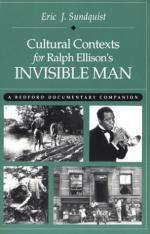|
This section contains 6,392 words (approx. 22 pages at 300 words per page) |

|
SOURCE: Foley, Barbara. “Reading Redness: Politics and Audience in Ralph Ellison's Early Short Fiction.” Journal of Narrative Theory 29, no. 3 (fall 1999): 323-39.
In the following essay, Foley contends that Ellison's early stories and journalism provide insights into his political and literary growth.
With the death of Ralph Ellison in April 1994 and the recent publication of his posthumous—and long-awaited—second novel, Juneteenth, the curve of the career of the author of Invisible Man would now appear to be complete. Although the version of Juneteenth produced by John Callahan, Ellison's literary executor, promises to be the topic of continuing controversy—particularly when the entire Ellison archive becomes available to the public—the novelist's oeuvre now exists in its totality, ready to provide grist for many a critical mill.1 Much of the coming wave of revisionary scholarship will no doubt consider Juneteenth as the endpoint of a life-long trajectory. What should...
|
This section contains 6,392 words (approx. 22 pages at 300 words per page) |

|


